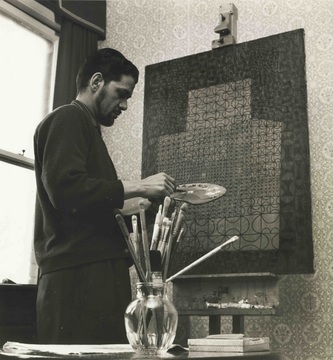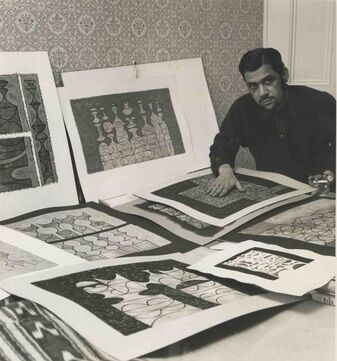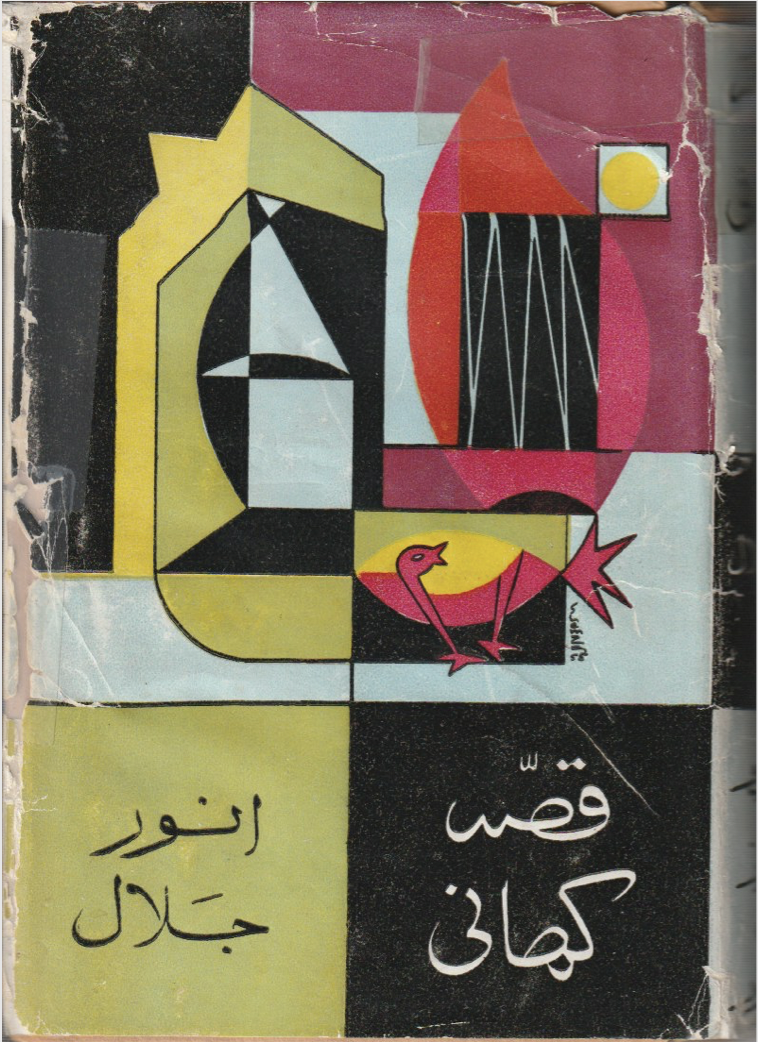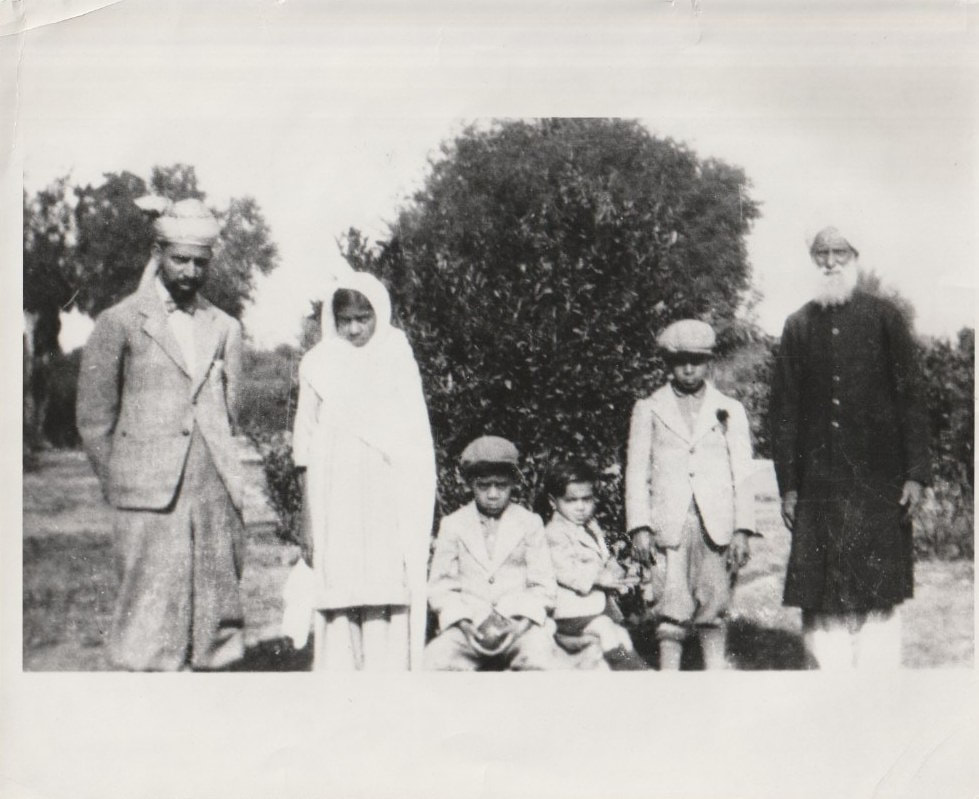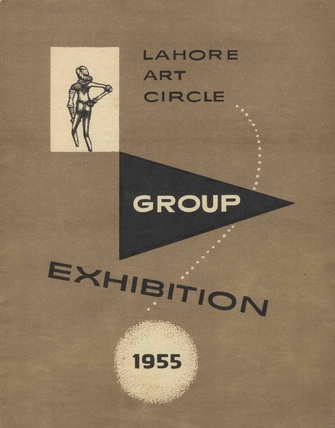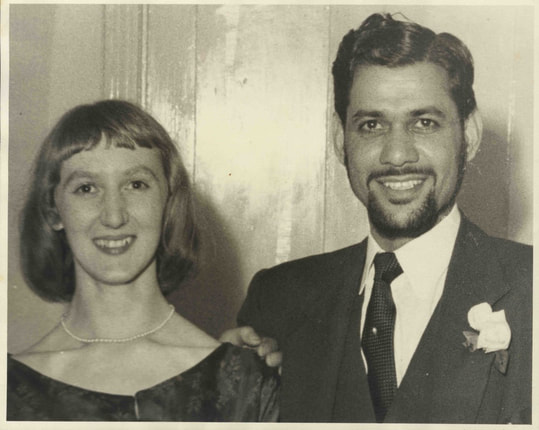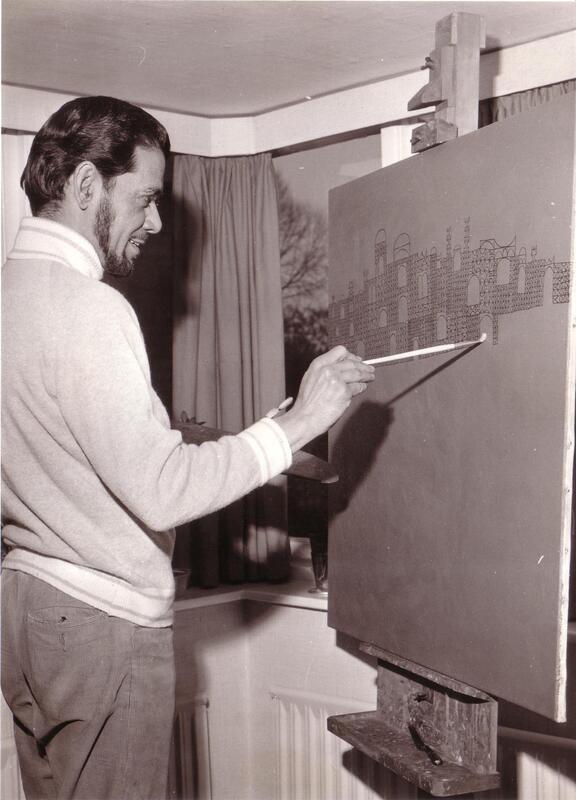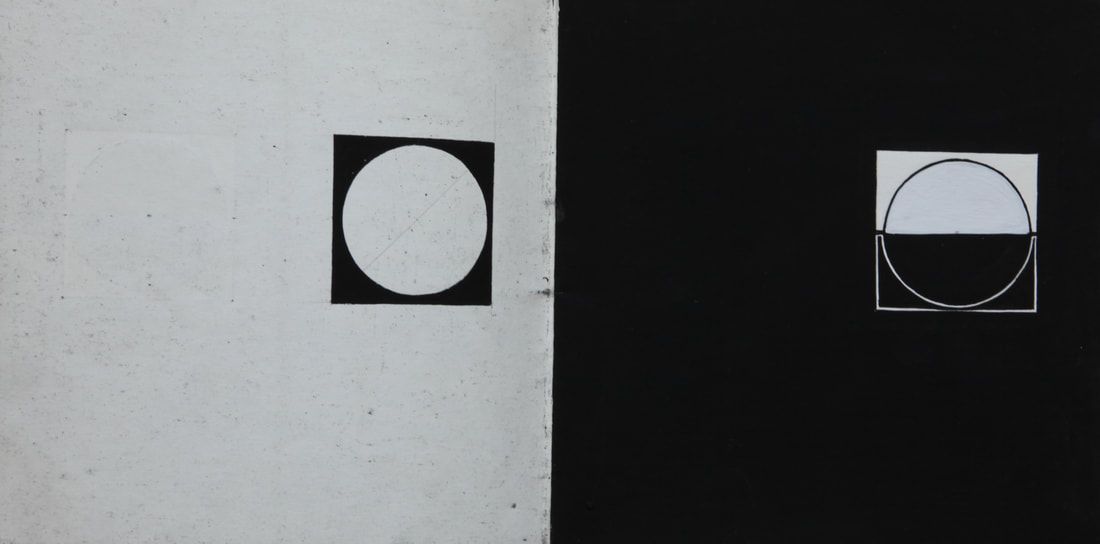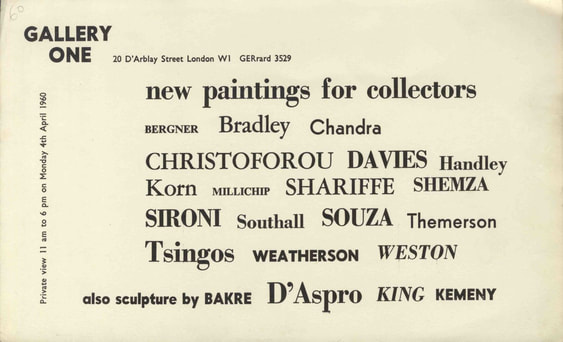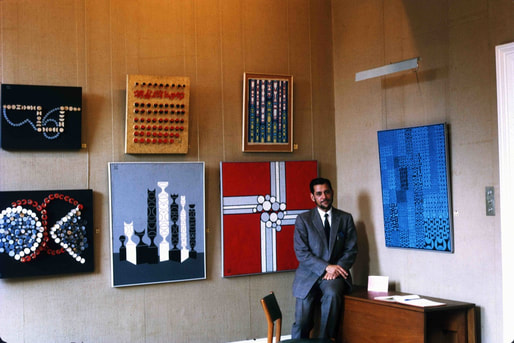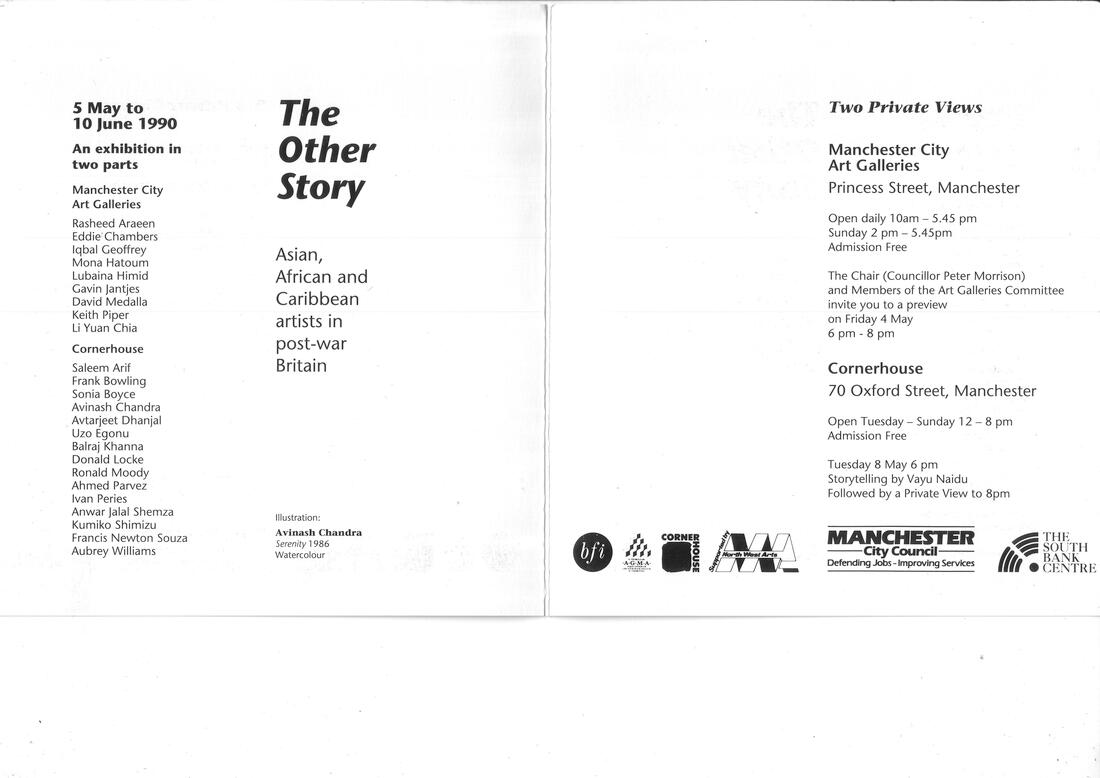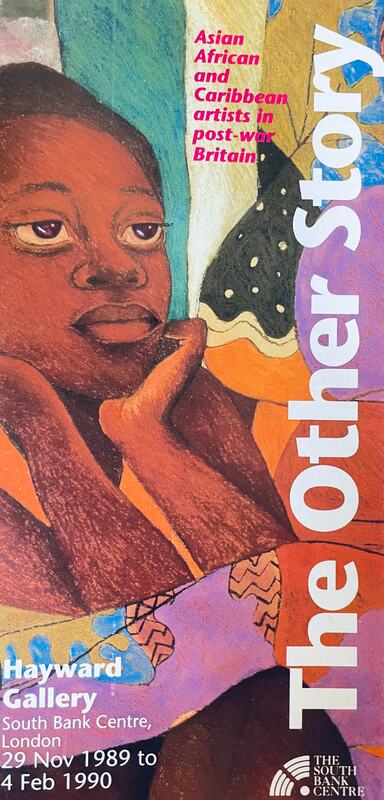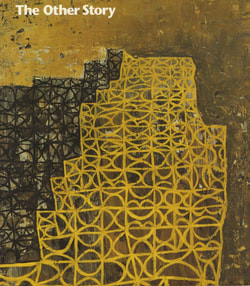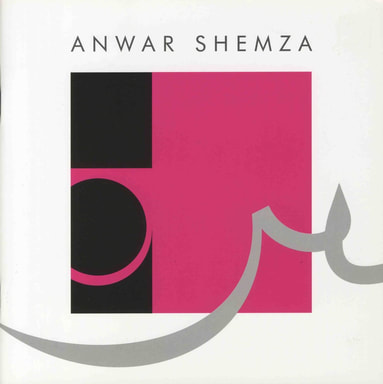Anwar Jalal Shemza (1928-1985)
1928
Born on 14 July in Simla to a Kashmiri and Punjabi family, who own a carpet and military embroidery business in Ludhiana.
1943
Begins study of Philosophy, Persian and Arabic at the University of the Punjab, Lahore.
1944
Transfers to Mayo School of Arts, Lahore due to a growing interest in art.
1947
Awarded a Commercial Art Diploma with distinction.
1947–50
Establishes a design studio in Lahore. Simultaneously works for the Government of Pakistan Public Relations Department, designing propaganda pamphlets, cinema slides, press layouts and magazine illustrations, and for the Visual Aids Section of the Education Department, creating a series of posters that promote adult education.
Born on 14 July in Simla to a Kashmiri and Punjabi family, who own a carpet and military embroidery business in Ludhiana.
1943
Begins study of Philosophy, Persian and Arabic at the University of the Punjab, Lahore.
1944
Transfers to Mayo School of Arts, Lahore due to a growing interest in art.
1947
Awarded a Commercial Art Diploma with distinction.
1947–50
Establishes a design studio in Lahore. Simultaneously works for the Government of Pakistan Public Relations Department, designing propaganda pamphlets, cinema slides, press layouts and magazine illustrations, and for the Visual Aids Section of the Education Department, creating a series of posters that promote adult education.
1950–53
Designs and edits Ehsas, an Urdu fortnightly periodical on art and literature.
1953–56
Four of Shemza’s novels are published in Urdu during this period. Achieves widespread recognition for literary and artistic endeavours as a member of the Lahore intelligentsia. Founding member of the Lahore Art Circle, which is concerned with modernism and abstraction. Participates in several solo and group exhibitions throughout Pakistan. Appointed head of the art department at Lawrence College, Public School for Boys, Ghora Gali and Cathedral High School, Lahore. Writes scripts for various stations of Radio Pakistan in the form of art and architecture programming and productions for children.
1956–57
Relocates to London for further study at the Slade School of Fine Art, London. Upon arrival in the UK, his Pakistani artistic achievements are not recognised. An existential crisis results in the destruction of previous artworks. Paul Klee assumes a major significance; embarks on the Heads series and a new body of drawing using ink.
1958
Marries fellow artist Mary Taylor; first daughter Tasveer is born a year later.
Designs and edits Ehsas, an Urdu fortnightly periodical on art and literature.
1953–56
Four of Shemza’s novels are published in Urdu during this period. Achieves widespread recognition for literary and artistic endeavours as a member of the Lahore intelligentsia. Founding member of the Lahore Art Circle, which is concerned with modernism and abstraction. Participates in several solo and group exhibitions throughout Pakistan. Appointed head of the art department at Lawrence College, Public School for Boys, Ghora Gali and Cathedral High School, Lahore. Writes scripts for various stations of Radio Pakistan in the form of art and architecture programming and productions for children.
1956–57
Relocates to London for further study at the Slade School of Fine Art, London. Upon arrival in the UK, his Pakistani artistic achievements are not recognised. An existential crisis results in the destruction of previous artworks. Paul Klee assumes a major significance; embarks on the Heads series and a new body of drawing using ink.
1958
Marries fellow artist Mary Taylor; first daughter Tasveer is born a year later.
1959–60
Earns a Diploma in Fine Art. Receives a British Council scholarship to study on an advanced course in printmaking at the Slade School of Fine Art, which concentrates on etching and is led by Anthony Gross. Included alongside Francis Newton Souza and Avinash Chandra in a number of group exhibitions in London. Exhibits in solo displays at New Vision Centre, London (1959) and Gallery One, London (1960). A new series, City Walls, attains a new compositional density by using layers of squares and circles.
1960
Relocates to Pakistan where the hope to undertake a senior position at his former alma mater, the National College of Arts (renamed from Mayo School of Arts in 1958), does not materialise. Despite some exhibitions and critical acclaim, Shemza is forced to work for an advertising firm in Karachi. Dissatisfied, Shemza returns to the UK with his family within the year.
1961
Settles in Stafford. Employed as an art teacher and continues with own practice during evenings and weekends. Following an introduction to John Coleman, colour printmaking becomes a major focus. Begins working on the Magic Carpet and Chessmen series.
1962
A number of international exhibitions over the next decade focus on drawing (Yugoslavia during 1963–70), printing (Japan during 1962–68; Austria in 1963; Switzerland in 1967) and engraving (Argentina during 1968–72).
1963
Starts to form two major bodies of work: Fingerprint and Square Compositions. Writes a major statement on his development as an artist, which is published in the catalogue accompanying a solo exhibition, A J Shemza: Paintings, Drawings, 1957–1964, at the Gulbenkian Museum of Oriental Art and Archaeology, Durham.
Earns a Diploma in Fine Art. Receives a British Council scholarship to study on an advanced course in printmaking at the Slade School of Fine Art, which concentrates on etching and is led by Anthony Gross. Included alongside Francis Newton Souza and Avinash Chandra in a number of group exhibitions in London. Exhibits in solo displays at New Vision Centre, London (1959) and Gallery One, London (1960). A new series, City Walls, attains a new compositional density by using layers of squares and circles.
1960
Relocates to Pakistan where the hope to undertake a senior position at his former alma mater, the National College of Arts (renamed from Mayo School of Arts in 1958), does not materialise. Despite some exhibitions and critical acclaim, Shemza is forced to work for an advertising firm in Karachi. Dissatisfied, Shemza returns to the UK with his family within the year.
1961
Settles in Stafford. Employed as an art teacher and continues with own practice during evenings and weekends. Following an introduction to John Coleman, colour printmaking becomes a major focus. Begins working on the Magic Carpet and Chessmen series.
1962
A number of international exhibitions over the next decade focus on drawing (Yugoslavia during 1963–70), printing (Japan during 1962–68; Austria in 1963; Switzerland in 1967) and engraving (Argentina during 1968–72).
1963
Starts to form two major bodies of work: Fingerprint and Square Compositions. Writes a major statement on his development as an artist, which is published in the catalogue accompanying a solo exhibition, A J Shemza: Paintings, Drawings, 1957–1964, at the Gulbenkian Museum of Oriental Art and Archaeology, Durham.
1959–60
Earns a Diploma in Fine Art. Receives a British Council scholarship to study on an advanced course in printmaking at the Slade School of Fine Art, which concentrates on etching and is led by Anthony Gross. Included alongside Francis Newton Souza and Avinash Chandra in a number of group exhibitions in London. Exhibits in solo displays at New Vision Centre, London (1959) and Gallery One, London (1960). A new series, City Walls, attains a new compositional density by using layers of squares and circles.
1960
Relocates to Pakistan where the hope to undertake a senior position at his former alma mater, the National College of Arts (renamed from Mayo School of Arts in 1958), does not materialise. Despite some exhibitions and critical acclaim, Shemza is forced to work for an advertising firm in Karachi. Dissatisfied, Shemza returns to the UK with his family within the year.
1961
Settles in Stafford. Employed as an art teacher and continues with own practice during evenings and weekends. Following an introduction to John Coleman, colour printmaking becomes a major focus. Begins working on the Magic Carpet and Chessmen series.
1962
A number of international exhibitions over the next decade focus on drawing (Yugoslavia during 1963–70), printing (Japan during 1962–68; Austria in 1963; Switzerland in 1967) and engraving (Argentina during 1968–72).
1963
Starts to form two major bodies of work: Fingerprint and Square Compositions. Writes a major statement on his development as an artist, which is published in the catalogue accompanying a solo exhibition, A J Shemza: Paintings, Drawings, 1957–1964, at the Gulbenkian Museum of Oriental Art and Archaeology, Durham.
Earns a Diploma in Fine Art. Receives a British Council scholarship to study on an advanced course in printmaking at the Slade School of Fine Art, which concentrates on etching and is led by Anthony Gross. Included alongside Francis Newton Souza and Avinash Chandra in a number of group exhibitions in London. Exhibits in solo displays at New Vision Centre, London (1959) and Gallery One, London (1960). A new series, City Walls, attains a new compositional density by using layers of squares and circles.
1960
Relocates to Pakistan where the hope to undertake a senior position at his former alma mater, the National College of Arts (renamed from Mayo School of Arts in 1958), does not materialise. Despite some exhibitions and critical acclaim, Shemza is forced to work for an advertising firm in Karachi. Dissatisfied, Shemza returns to the UK with his family within the year.
1961
Settles in Stafford. Employed as an art teacher and continues with own practice during evenings and weekends. Following an introduction to John Coleman, colour printmaking becomes a major focus. Begins working on the Magic Carpet and Chessmen series.
1962
A number of international exhibitions over the next decade focus on drawing (Yugoslavia during 1963–70), printing (Japan during 1962–68; Austria in 1963; Switzerland in 1967) and engraving (Argentina during 1968–72).
1963
Starts to form two major bodies of work: Fingerprint and Square Compositions. Writes a major statement on his development as an artist, which is published in the catalogue accompanying a solo exhibition, A J Shemza: Paintings, Drawings, 1957–1964, at the Gulbenkian Museum of Oriental Art and Archaeology, Durham.
1989
Included in The Other Story: Afro-Asian Artists in Post-War Britain, a major exhibition demonstrating an alternative to the mainstream Western artistic canon of modern art, curated by Rasheed Araeen, at the Hayward Gallery, London. The cover of the exhibition catalogue includes a reproduction of The Wall (1958).
1997
The first major UK retrospective of the artist’s work opens at Birmingham Museum and Art Gallery, Birmingham.
2007–12
Anita Dawood and Hammad Nasar of Green Cardamom, London represent the Estate of Anwar Jalal Shemza. The gallery presents two solo exhibitions Calligraphic Abstraction, curated by Iftikhar Dadi (2009), and The British Landscape, curated by Rachel Garfield (2010). Included in the group exhibition Migrations: Journeys into British Art, at Tate Britain, London in 2012, which revisits the themes of The Other Story: Afro-Asian Artists in Post-War Britain.
Included in The Other Story: Afro-Asian Artists in Post-War Britain, a major exhibition demonstrating an alternative to the mainstream Western artistic canon of modern art, curated by Rasheed Araeen, at the Hayward Gallery, London. The cover of the exhibition catalogue includes a reproduction of The Wall (1958).
1997
The first major UK retrospective of the artist’s work opens at Birmingham Museum and Art Gallery, Birmingham.
2007–12
Anita Dawood and Hammad Nasar of Green Cardamom, London represent the Estate of Anwar Jalal Shemza. The gallery presents two solo exhibitions Calligraphic Abstraction, curated by Iftikhar Dadi (2009), and The British Landscape, curated by Rachel Garfield (2010). Included in the group exhibition Migrations: Journeys into British Art, at Tate Britain, London in 2012, which revisits the themes of The Other Story: Afro-Asian Artists in Post-War Britain.
2012–15
Jhaveri Contemporary, Mumbai represents the Estate of Anwar Jalal Shemza. A selection of Square Compositions is displayed at the gallery’s solo stand at Art Dubai (2014). Shown in numerous international group exhibitions, including Burning Down the House, 10th Gwangju Biennale, Gwangju and Trajectories: 19th–21st Century Printmaking from India and Pakistan, Sharjah Art Museum, Sharjah (both 2014). A solo BP Spotlight display opens at Tate Britain in October 2015, which includes paintings and prints drawn from the Tate’s collection.
2017
Jhaveri Contemporary continues to exhibit and work with the Estate. The Estate also starts to work with Hales Gallery both in New York and London.
2018
Hales Gallery holds their first exhibition of Shemza's work in New York (Kamroom Aram and Anwar Shemza) and in London (Paintings from the 1960s). Aswell as exhibiting Shemza's work at the Armory in New York. Shemza's work is featured in South Asian Modernists at the Whitworth, Manchester curated by Amrita Jhaveri.
2019
Hales Gallery exhibit Shemza's work at Frieze London and Art Basel Miami Beach. Works are placed with M+ Museum and the Sharjah Art Foundation by Jhaveri Contemporary. Work is exhibited in the Sharjah Biennial 14 curated by Omar Kholief and in Speech Acts at Manchester Art Gallery, curated by Hammad Nasar.
2020
Aphra Shemza & Stuart Batchelor launch shemza.digital, a participatory digital art project to extend Shemza's legacy for current and future generations. Jhaveri Contemporary exhibit Shemza's work at the Indian Art Fair, Green Art Gallery in Dubai and Black Beyond Site at their gallery in India. A selection of Shemza's photograms are exhibited for the first time in the Art Basel Online edition.
2021
Shemza and The Lahore Art Circle are part of ‘Group Dynamics: Collectives of the Modernist Period’ at Lenbachhaus Munich. The second stage of shemza.digital takes place with numerous public workshops and an online exhibition. Hales Gallery facilitates the placement of Blue Composition with Minneapolis Institute of Art.
2022
Works by Shemza are included in ‘A Century of The Artist’s Studio: 1920-2020’, Whitechapel Gallery, ‘PostWar Modern’, Barbican, ‘Radical Landscapes’, Tate Liverpool and Mead Gallery Warwick Arts Centre, and ‘In The Heart of Another Country’, Diechtorhallen Hamburg. The third stage of shemza.digital launches with physical exhibitions from January 2023.
Jhaveri Contemporary, Mumbai represents the Estate of Anwar Jalal Shemza. A selection of Square Compositions is displayed at the gallery’s solo stand at Art Dubai (2014). Shown in numerous international group exhibitions, including Burning Down the House, 10th Gwangju Biennale, Gwangju and Trajectories: 19th–21st Century Printmaking from India and Pakistan, Sharjah Art Museum, Sharjah (both 2014). A solo BP Spotlight display opens at Tate Britain in October 2015, which includes paintings and prints drawn from the Tate’s collection.
2017
Jhaveri Contemporary continues to exhibit and work with the Estate. The Estate also starts to work with Hales Gallery both in New York and London.
2018
Hales Gallery holds their first exhibition of Shemza's work in New York (Kamroom Aram and Anwar Shemza) and in London (Paintings from the 1960s). Aswell as exhibiting Shemza's work at the Armory in New York. Shemza's work is featured in South Asian Modernists at the Whitworth, Manchester curated by Amrita Jhaveri.
2019
Hales Gallery exhibit Shemza's work at Frieze London and Art Basel Miami Beach. Works are placed with M+ Museum and the Sharjah Art Foundation by Jhaveri Contemporary. Work is exhibited in the Sharjah Biennial 14 curated by Omar Kholief and in Speech Acts at Manchester Art Gallery, curated by Hammad Nasar.
2020
Aphra Shemza & Stuart Batchelor launch shemza.digital, a participatory digital art project to extend Shemza's legacy for current and future generations. Jhaveri Contemporary exhibit Shemza's work at the Indian Art Fair, Green Art Gallery in Dubai and Black Beyond Site at their gallery in India. A selection of Shemza's photograms are exhibited for the first time in the Art Basel Online edition.
2021
Shemza and The Lahore Art Circle are part of ‘Group Dynamics: Collectives of the Modernist Period’ at Lenbachhaus Munich. The second stage of shemza.digital takes place with numerous public workshops and an online exhibition. Hales Gallery facilitates the placement of Blue Composition with Minneapolis Institute of Art.
2022
Works by Shemza are included in ‘A Century of The Artist’s Studio: 1920-2020’, Whitechapel Gallery, ‘PostWar Modern’, Barbican, ‘Radical Landscapes’, Tate Liverpool and Mead Gallery Warwick Arts Centre, and ‘In The Heart of Another Country’, Diechtorhallen Hamburg. The third stage of shemza.digital launches with physical exhibitions from January 2023.

